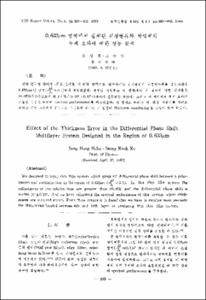신생아 외과질환에서의 재태기간과 출생체중의 관계
- Alternative Title
- Gestational Age and Birth Weight in Neonatal Surgical Diseases
- Abstract
- Gestational age and birth weight are closely correlated with each other, and these are major determinants of perinatal morbidity and mortality. Many neonates with congenital anomalies are premature and of low birth weight. Intrauterine growth retardation can be caused either by congenital malformation itself or by the conditions brings about congenital malformation.
In the cases with prenatal diagnosis, it is ideal for a mother to deliver an affected fetus at full-term for maximal fetal growth and a better prognosis, But several factors, such as fetal growth, organ maturation and the detrimental effect of malformation, must be considered for the optimal time of delivery. Therefore, it is important whether the affected fetus gains body weight continuously throughout the intrauterine period.
We found that midgut volvulus, esophageal atresia, Hirschsprung's disease, and jejunoileal atresia showed a positive correlation between gestational age and birth weight. On the contrary, meconium peritonitis, duodenal atresia, diaphragmatic hernia, anorectal malformation, gastroschisis and omphalocele did not gai body weight through the 3rd trimester of pregnancy.
We consider that this finding will aid the optimal time of delivery of the fetus with congenital malformation, diagnosed prenatally.
Gestational age and birth weight are closely correlated with each other, and these are major determinants of perinatal morbidity and mortality. Many neonates with congenital anomalies are premature and of low birth weight. Intrauterine growth retardation can be caused either by congenital malformation itself or by the conditions brings about congenital malformation.
In the cases with prenatal diagnosis, it is ideal for a mother to deliver an affected fetus at full-term for maximal fetal growth and a better prognosis, But several factors, such as fetal growth, organ maturation and the detrimental effect of malformation, must be considered for the optimal time of delivery. Therefore, it is important whether the affected fetus gains body weight continuously throughout the intrauterine period.
We found that midgut volvulus, esophageal atresia, Hirschsprung's disease, and jejunoileal atresia showed a positive correlation between gestational age and birth weight. On the contrary, meconium peritonitis, duodenal atresia, diaphragmatic hernia, anorectal malformation, gastroschisis and omphalocele did not gai body weight through the 3rd trimester of pregnancy.
We consider that this finding will aid the optimal time of delivery of the fetus with congenital malformation, diagnosed prenatally.
- Issued Date
- 1995
- Type
- Research Laboratory
- Alternative Author(s)
- Kim, In Koo; Kim, Seong Chul
- Publisher
- 울산의대학술지
- Language
- kor
- Rights
- 울산대학교 저작물은 저작권에 의해 보호받습니다.
- Citation Volume
- 4
- Citation Number
- 1
- Citation Start Page
- 62
- Citation End Page
- 66
- Appears in Collections:
- Research Laboratory > The ULSAN university medical journal
- 파일 목록
-
-
Download
 000002023753.pdf
기타 데이터 / 486.9 kB / Adobe PDF
000002023753.pdf
기타 데이터 / 486.9 kB / Adobe PDF
-
Items in Repository are protected by copyright, with all rights reserved, unless otherwise indicated.